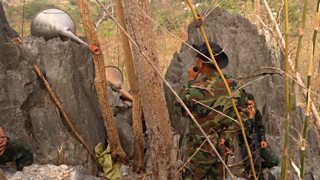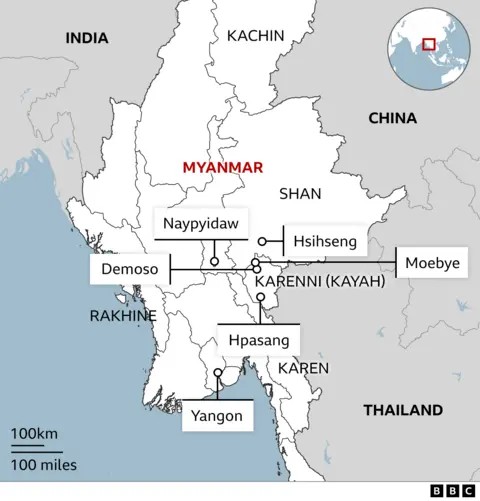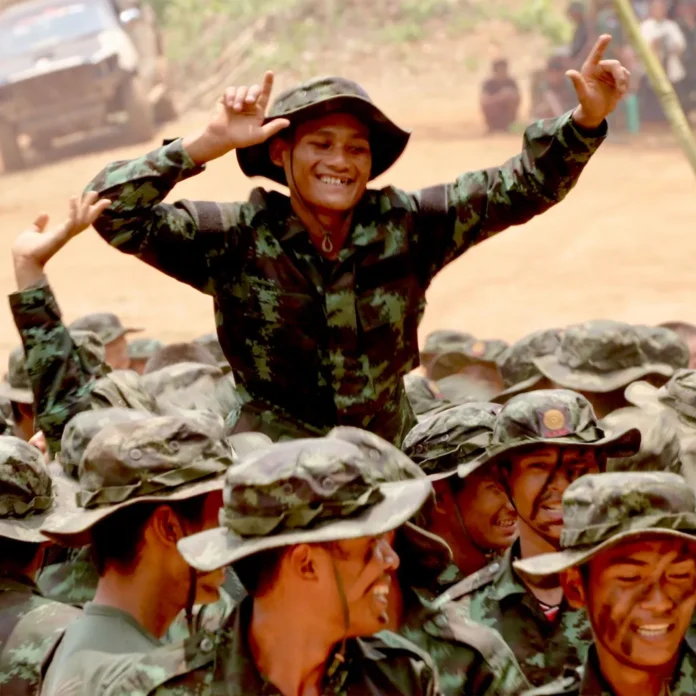It’s a blisteringly hot day – above 40C – and behind, on bamboo poles, more young resistance fighters carry a large, heavy battery pack and amplifier. Leading the ascent is Nay Myo Zin, a former army captain who, after 12 years in the military, defected to the resistance.
With his dark green camouflage jacket draped over one shoulder, he has the air of a performer about to take the stage. He is here to urge the soldiers in the base below, who are loyal to the country’s ruling military, to switch sides.

In this jungle deep in Karenni state in the east of Myanmar, two forces face each other in a fight that has, in one way or another, been going on for decades. But the rapid advances by the resistance in recent months indicate that this time they may have the advantage.
The South East Asian nation is at a crossroads – after decades of military rule and brutal repression, ethnic groups, along with a new army of young insurgents, have brought the dictatorship to crisis point.
In the past seven months, somewhere between half and two-thirds of the country has fallen to the resistance. Tens of thousands of people have been killed, including many children, since the military seized power in a coup in 2021. Some 2.5 million have been displaced, and the military facing an unprecedented challenge to its rule and in an attempt to thwart the growing resistance regularly bombs civilians, schools and churches from its warplanes (the resistance has none).

Before Nay Myo Zin’s sound equipment is switched on, the army opens fire on his position.
Undeterred, with a flick of the switch and microphone in hand, he bellows: “Everyone, cease fire! Cease fire, please. Just listen for five minutes, 10 minutes.” Somewhat surprisingly, the barrage stops.
He tells them of the 4,000 soldiers who surrendered to the opposition in northern Shan State, and the recent insurgent drone attacks on military buildings in the country’s capital Napidaw. The message is, we are winning, your regime is falling, it is time to give up.
Here in Hpasang and across Karenni state, across much of the country, battles and stalemates have taken hold as a great rolling rebellion threatens the rule of the military junta. The military coup in 2021 brought an end to the elected civilian government, and its leader Aung San Suu Kyi remains imprisoned, along with other political leaders.
Yet this is an under-reported conflict – with much of the world’s attention on Ukraine and the Israel-Gaza conflict. There is no press freedom, foreign journalists are rarely allowed to enter officially and when they do are heavily monitored. There is no way to hear the resistance side of this story through government approved visits.
We travelled into Myanmar and spent a month in the east of the country living alongside resistance groups fighting across Karenni State, which borders Thailand, and Shan state, which borders China.
We travelled on jungle tracks and backroads, to front lines where the military has been cut-off and surrounded for weeks, where like in Hpasang, the fighters have the high ground. In others, such as Moebye, further north, the opposition has suffered heavy losses as it attempted direct assaults across heavily mined ground. There, and in Loikaw, the state capital, the strength of the rebellion, and its limitations are in plain view.






